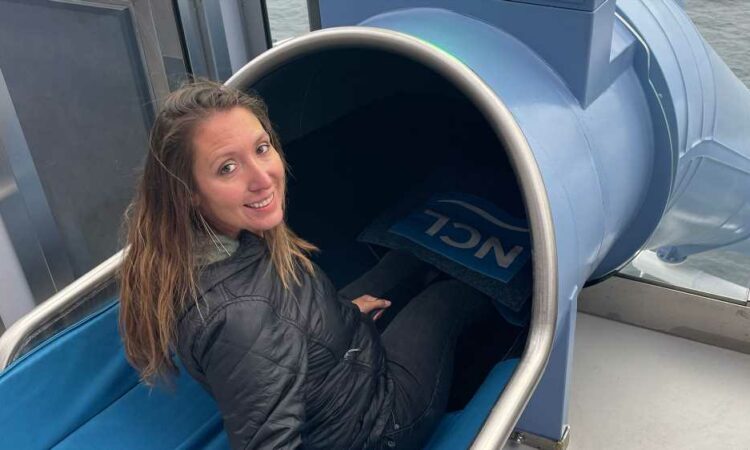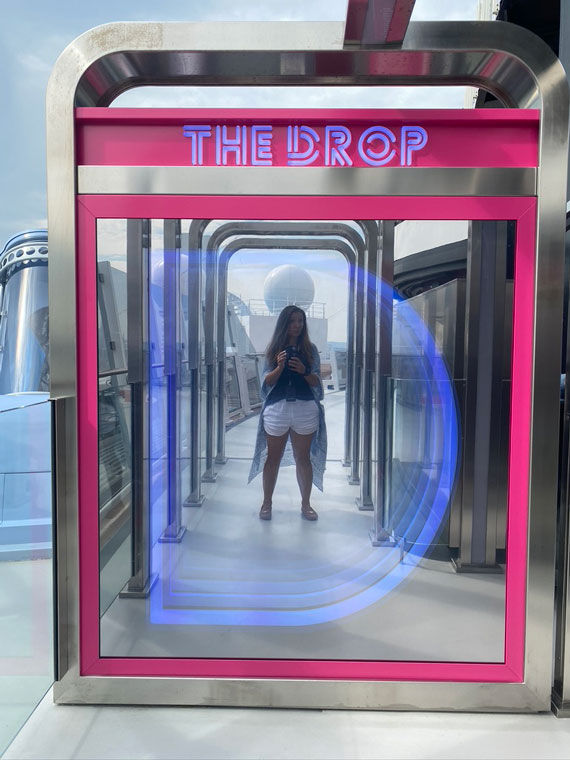ABOARD THE NORWEGIAN PRIMA — One by one, the thrill-seekers ahead of me in line climb into a vertical tube akin to a human-size drive-thru bank chute. And just like my bank deposit in the days before mobile banking, I blink and the contents are gone. All I hear is the whoosh of air behind them.
Cruise lines, especially those that pride themselves on rides and games to attract families, are good at claiming notoriety for something. In the case of the Norwegian Prima, which debuted a week ago in Iceland on an inaugural voyage to Amsterdam, it claims to have the world’s first freefall dry slide at sea with a gravitational force “faster than an accelerating F1 race car.”
“What we wanted to do was take things that we know and love from our previous ships and innovate and make them better, and in addition to that bring new, exciting concepts as well,” said Simon Murray, vice president of guest experiences and innovation for NCL.
The ship is the first in the new Prima class. Carrying 3,099 passengers at double capacity, the Prima is expected to be followed around this time next year by the Norwegian Viva and four more ships between now and 2027.
The Prima is full of toys that rely on technology. Its largest go-kart track spans three decks and allows onlookers to use a laser gun to give a turbo boost to racers. There’s a new darts game concept and a virtual-reality arcade called the Galaxy Pavilion with five one-of-a-kind head-spinning games and rides.
But there’s something special about a slide that involves little more than a metal tube and gravitational force to get the heart racing.
The Prima has three dry slides that curl around the exterior of the ship. A pair of slides are called “The Rush” and allow guests to race to the bottom, which was a thrill as I sped down so fast I felt like a kid again.
The other with the bank tube is the Drop, a slide that begins with the floor dropping out from beneath your feet for the “highest G-forces of any cruise line.”
Each slide begins on Deck 18 and shoots riders down a curved and covered metal tube that spits them out at a landing area 10 decks below. Both pads are just outside the Local Bar and Grill, and after several trips down them in the name of journalism, I worked up a surprising appetite.
- Related: Norwegian Prima puts luxury touches in a big-ship package
Now it’s my turn for The Drop. I climb into the clear capsule and I’m standing in a sleeping-bag-like liner that contains my feet and shields my rear from friction. This liner is open in the middle and has wings I wrap around myself like a bat to keep my hands and arms contained. As the door to the cylinder closes, I come to grips that this is happening. Then the attendant speaks into a microphone that pipes into my tube. “Have fun.”
A countdown begins and within several excruciating seconds, the floor drops out from under me. It’s such a surprise that I yelp as I plunge down the dark tube. For a moment before it curves to the right, it’s pitch black and I’m flying so fast I’m in disbelief. Then I enter a clear segment of the slide that both slows me down and gives me a view of the sky — and more terrifyingly, the ocean below. Then, it’s back into darkness as the slide curves and I pick up speed until I eventually spit out at the landing pad.
That was my experience the first time I rode the slide. We had just departed Iceland the night before when the air was dry. I rode down again four days later in Le Havre, France, with 70% percent humidity. While the drop gave me that initial burst of speed I experienced my first time, I was remarkably slower the rest of the way down.
The same goes for The Rush: I zoomed down and was blown away by the speed when I slid down outside of Iceland, but the second time around I was so slow that I came to a halt just short of the mouth of the slide.
I suspect the humidity had something to do with it. When I asked NCL why that was, I didn’t get a clear response. A spokesperson eventually told me it was weather-related.
The slides are shockingly fast, but you’ve got to ride down them in the right conditions.
Source: Read Full Article


